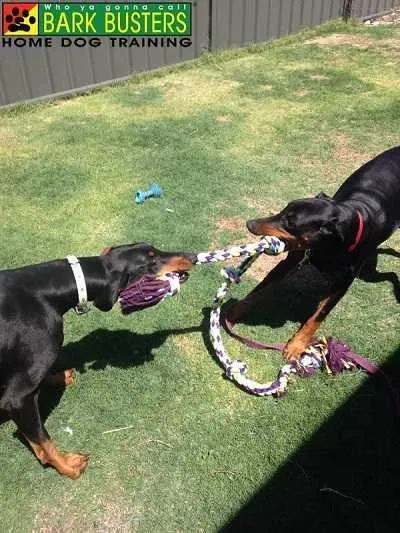Dogs Teaching Dogs

Just like older brothers and sisters teach their younger siblings, so too do dogs - both good and bad habits! As parents, we generally have more time to spend with the older child since at that point they are the only child.
This often happens with dogs. Many dog owners spend a lot of time teaching the older dog how to fit into the family. You hopefully have imposed some rules, and through repetition and training have a well-behaved older dog.
For instance, I taught my older dog to stay out of the kitchen. Fortunately, since my older dog doesn't go in this room, my younger dog caught on that he shouldn't either. I also taught my older dog to stay off the furniture. The younger one never tried to get up on the furniture because he's never seen the older one on the furniture.
The same thing with waiting at the door, waiting for permission to eat and waiting to get in or out of the car and a number of other things. He learned all those things just by watching our older dog. I really didn't have to do anything to teach him the rules.
Recently they had two playmates come over. Our dogs love to play "Fetch" and are really good at retrieving the ball. By the end of the day, their playmates learned to bring the ball back and to play "Tug".
I've used my dogs to help teach other dogs to climb stairs, get into cars and a few other things.
Dogs, when they are together, watch what each other do. One of the ways they learn is by observing.
When dogs live together they always affect each other's behaviour in various ways. It can be difficult, if not impossible to completely isolate behaviour when there are multiple dogs. With multiple dogs it's best to start with the dog that has the most authority within the group as most likely that dog is running things amongst them. Yes, dogs do establish an authority hierarchy with those they live with, both dogs and people.
- I worked with a family who has five dogs. It was complete chaos when someone came to the door. All five dogs would bark excitedly and jump repeatedly on who ever came in, even the family members. We started with only the lead dog and began teaching her a different response. Once she was pretty good, we added a second dog, that one was much easier, the third was even easier and by the time we got to the last two, it went really quick because they were all taking their cues from that first one.
- I also helped a young woman with two dogs. She has a Corgi and a big Shepherd mix. Her concern was the Shepherd. He would bark aggressively at people and dogs and when walking would lunge at anyone coming near. After observing them and their interactions, I recognised that the Corgi was actually the bigger problem. She would bark once at someone and that set the Shepherd off. She would then just watch the Shepherd go into his routine. She was the queen and he was her bodyguard. We concentrated on working with the Corgi and the Shepherd settled right down. Our client was able to relax and not worry about her big dog once she got the queen to give up her throne and not react to the people and other dogs.
- I've also worked with a family who just wanted help with their new puppy. Their older dog wasn't a problem. We would work with them and the puppy and invariably when I asked how things were going, they would tell me they were struggling. The puppy was barking at them and not listening to them. I finally asked them to humour me and not put the older dog away when we came. We were sitting in the kitchen and the older dog went to the refrigerator and barked. Both people started to get up from the table. I asked what they were doing. They said the dog wanted an ice cube. After I stopped chuckling to myself I explained why they were having a hard time with the puppy. It had been seeing the relationship they had with the older dog and was copying its behaviour. Once they realised the dynamics and worked with the older dog, they didn't need any further help with the puppy.
Time after time I see how dogs teach each other, sometimes its good things, sometimes not, but they do watch and learn from each other. If you have multiple dogs, you have to take their relationships with each other and with you into consideration. Dogs are not people -- they look at life differently than we do, they communicate differently than we do and their relationships are different. This is natural because they are a different species. They can't change how they view things so it's up to us to make adjustments and look at situations from their perspective. You know the results when we do.
By the way, in the examples above, I am assuming the older dog is well trained so he can be a role model for the younger one. Otherwise, you'll have two badly behaved dogs running around the double the trouble!
Recent Articles
- Leash Training - How to Stop your Dog from Pulling on Walks
- Dog Aggression Training & Tips
- Halloween Safety Tips for Dog Owners
- Why Is My Dog Barking So Much? Understanding Excessive Barking and How To Help
- Understanding and Training Dogs with Separation Anxiety
- Dogs need education too!
- Winter woes? A dog-lover's guide to solving winter blues
- The Importance of Dog Training
- The Truth About Those Dog Myths
- You Can Prevent Dog Bites
